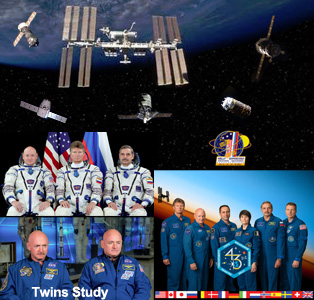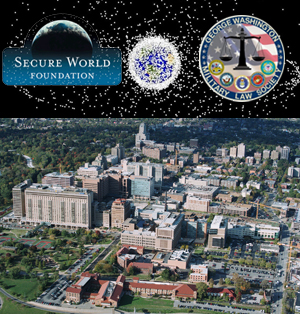Launch Expedition 43/44 Crew, Kelly and Kornienko to Begin 1-Year Mission on ISS
|
MONDAY
|

![]() = All times for terrestrial events in local time unless noted.
= All times for terrestrial events in local time unless noted.
![]() = All times for international terrestrial events in local time unless noted.
= All times for international terrestrial events in local time unless noted.
![]() = All times for space events, and…
= All times for space events, and…
![]() = All times for international space / astro events in Hawaii Standard Time unless noted. Add 10 hours to obtain UT (‘Universal Time;’ Greenwich, England).
= All times for international space / astro events in Hawaii Standard Time unless noted. Add 10 hours to obtain UT (‘Universal Time;’ Greenwich, England).
Weekly Planet Watch – Evening Planets: Venus (W), Mars (W), Jupiter (SE); Morning Planets: Saturn (S).
Secure World Foundation Panel Discussion at George Washington University
The Secure World Foundation and the George Washington Military Law Society host a luncheon panel discussion from 12:00-14:00 on Monday, March 23, 2015 at the GWU Campus in Washington DC. SWF works with governments, industry, international organizations and civil society to develop and promote ideas and actions for international collaboration that achieve the secure, sustainable and peaceful uses of outer space. This panel discussion focuses on the relationship between international law and military activities in space. The panel is moderated by Brian Weeden, Technical Advisor at SWF and the speakers are: Wing Commander Duncan Blake, Royal Australian Air Force; Gary Brown, Head of Communications, Washington Delegation, International Committee of the Red Cross; Cassandra Steer, Executive Director, Centre of Research in Air and Space Law, McGill University; Peter Hays, Adjunct Professor, George Washington University. SWF is based in Broomfield CO, USA and also maintains an office in Washington, DC. It is lead by Executive Director Dr. Michael Simpson, who is a prominent figure in the space community as former President of the International Space University among other roles. In addition to Space Sustainability, Space Law and Policy, and Human and Environmental Security, SWF is intensely focused on Planetary Defense from the threat of NEOs and asteroids. (Image Credit: SWF, GWU, NASA)
|
Continued from…
TUESDAY
|
![]() Mar 24-26 — Ames Research Center, NASA, SETI Institute, Moffett Field CA: Planetary Protection Knowledge Gaps for Human Extraterrestrial Missions; focusing on microbial & human health monitoring, technology & operations for contamination control, natural transport of contamination on Mars.
Mar 24-26 — Ames Research Center, NASA, SETI Institute, Moffett Field CA: Planetary Protection Knowledge Gaps for Human Extraterrestrial Missions; focusing on microbial & human health monitoring, technology & operations for contamination control, natural transport of contamination on Mars.
![]() Mar 24-26 — ESA, Noordwijk, The Netherlands: Workshop: Simulation & Electrical Ground Support Equipment Facilities for Space Programmes.
Mar 24-26 — ESA, Noordwijk, The Netherlands: Workshop: Simulation & Electrical Ground Support Equipment Facilities for Space Programmes.
![]() Mar 24 — Moon: 8.1° S of Pleiades, 03:00; 1.3° NW of Aldebaran, 21:00.
Mar 24 — Moon: 8.1° S of Pleiades, 03:00; 1.3° NW of Aldebaran, 21:00.
WEDNESDAY
![]() Mar 25 — ULA, Launch Delta 4 / GPS 2F-9, Cape Canaveral AFS FL: United Launch Alliance Delta 4 rocket to launch U.S. Air Force ninth Block 2F navigation satellite for Global Positioning System.
Mar 25 — ULA, Launch Delta 4 / GPS 2F-9, Cape Canaveral AFS FL: United Launch Alliance Delta 4 rocket to launch U.S. Air Force ninth Block 2F navigation satellite for Global Positioning System.
![]() Mar 25 — Space Florida, Tallahassee FL: Florida Space Day; to educate & bring awareness to Florida legislators on significance of aerospace industry & its impact on Florida economy.
Mar 25 — Space Florida, Tallahassee FL: Florida Space Day; to educate & bring awareness to Florida legislators on significance of aerospace industry & its impact on Florida economy.
![]() Mar 25 — American Astronautical Society, American Meteorological Society, Northrop Grumman, Online: Google Hangout: Women in Weather; 12:00 EDT.
Mar 25 — American Astronautical Society, American Meteorological Society, Northrop Grumman, Online: Google Hangout: Women in Weather; 12:00 EDT.
THURSDAY
![]() Mar 26 — JAXA, Launch H-2A / IGS Optical 5, Tanegashima Space Center, Japan: JAXA to launch information gathering satellite with an optical reconnaissance payload for Japan government.
Mar 26 — JAXA, Launch H-2A / IGS Optical 5, Tanegashima Space Center, Japan: JAXA to launch information gathering satellite with an optical reconnaissance payload for Japan government.
![]() Mar 26 — RSA, Launch Dnepr / KOMPSat 3A, Yasny Cosmodrome, Dombarovsky, Russia: An ISC Kosmotras Dnepr rocket to launch Kompsat 3A Earth observation satellite for Korea Aerospace Research Institute (KARI).
Mar 26 — RSA, Launch Dnepr / KOMPSat 3A, Yasny Cosmodrome, Dombarovsky, Russia: An ISC Kosmotras Dnepr rocket to launch Kompsat 3A Earth observation satellite for Korea Aerospace Research Institute (KARI).
![]() Mar 26, 27 — Jet Propulsion Laboratory, Caltech/NASA, Pasadena CA: von Kármán Lecture Series: Adventures From the Field – (Down and Dirty) Stories of Pursuing JPL Science from the Ground up to Space; presented by Mark Helmlinger of JPL.
Mar 26, 27 — Jet Propulsion Laboratory, Caltech/NASA, Pasadena CA: von Kármán Lecture Series: Adventures From the Field – (Down and Dirty) Stories of Pursuing JPL Science from the Ground up to Space; presented by Mark Helmlinger of JPL.
![]() Mar 26 — Moon: 6.2° S of M35, 14:00; at first quarter, 21:43.
Mar 26 — Moon: 6.2° S of M35, 14:00; at first quarter, 21:43.
![]() Mar 26 — Asteroid 2015 FC: Near-Earth flyby (0.007 AU).
Mar 26 — Asteroid 2015 FC: Near-Earth flyby (0.007 AU).
![]() Mar 26 — Asteroid 325102 (2008 EY5): Near-Earth flyby (0.082 AU).
Mar 26 — Asteroid 325102 (2008 EY5): Near-Earth flyby (0.082 AU).
FRIDAY
![]() Mar 27 — RSA, Launch Soyuz TMA-16M / ISS 42S, Baikonur Cosmodrome, Kazakhstan: An RSA Soyuz rocket set to launch members of Expedition 43/44: Gennady Padalka of RSA, Mikhail Kornienko of RSA, Scott Kelly of NASA; Kornienko and Kelly will begin 1 full year mission aboard ISS.
Mar 27 — RSA, Launch Soyuz TMA-16M / ISS 42S, Baikonur Cosmodrome, Kazakhstan: An RSA Soyuz rocket set to launch members of Expedition 43/44: Gennady Padalka of RSA, Mikhail Kornienko of RSA, Scott Kelly of NASA; Kornienko and Kelly will begin 1 full year mission aboard ISS.
![]() Mar 27 — Arianespace, Launch Soyuz / Galileo FOC-2, Kourou, French Guiana: Arianespace Soyuz rocket, designated VS11, to launch 2 Galileo satellites for Europe Galileo navigation constellation.
Mar 27 — Arianespace, Launch Soyuz / Galileo FOC-2, Kourou, French Guiana: Arianespace Soyuz rocket, designated VS11, to launch 2 Galileo satellites for Europe Galileo navigation constellation.
![]() Mar 27 — International Academy of Astronautics, Online / Prague, Czech Republic: Abstracts Due: 20th IAA Humans in Space Symposium; to be held Jun 29 – Jul 3.
Mar 27 — International Academy of Astronautics, Online / Prague, Czech Republic: Abstracts Due: 20th IAA Humans in Space Symposium; to be held Jun 29 – Jul 3.
![]() Mar 27 — Asteroid 2014 YB35: Near-Earth flyby (0.030 AU).
Mar 27 — Asteroid 2014 YB35: Near-Earth flyby (0.030 AU).
SATURDAY
![]() Mar 28 — Federation of Galaxy Explorers, Chapel Hill NC: Battle of the Rockets 2015; at Battle Park.
Mar 28 — Federation of Galaxy Explorers, Chapel Hill NC: Battle of the Rockets 2015; at Battle Park.
![]() Mar 28-29 — AIAA, University of Nevada, Reno NV: 2015 AIAA Region VI Student Conference.
Mar 28-29 — AIAA, University of Nevada, Reno NV: 2015 AIAA Region VI Student Conference.
![]() Mar 28 — Moon: 11.8° S of Pollux, 07:00.
Mar 28 — Moon: 11.8° S of Pollux, 07:00.
![]() Mar 28 — Asteroid 2015 FP: Near-Earth flyby (0.025 AU).
Mar 28 — Asteroid 2015 FP: Near-Earth flyby (0.025 AU).
SUNDAY
![]() Mar 29 — Israel Society for Astrobiology and the Study of the Origin of Life (ILASOL), Beersheva, Israel: 28th Annual Meeting of the ILASOL; at Ben-Gurion University
Mar 29 — Israel Society for Astrobiology and the Study of the Origin of Life (ILASOL), Beersheva, Israel: 28th Annual Meeting of the ILASOL; at Ben-Gurion University
![]() Mar 29 — Daylight Saving Time (Europe): Change clocks forward 1 hour, from Standard Time to Summer Time.
Mar 29 — Daylight Saving Time (Europe): Change clocks forward 1 hour, from Standard Time to Summer Time.
![]() Mar 29 — Moon: 5.4° SSW of Jupiter, 22:00.
Mar 29 — Moon: 5.4° SSW of Jupiter, 22:00.

